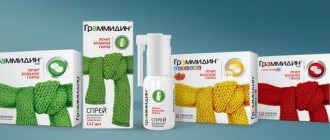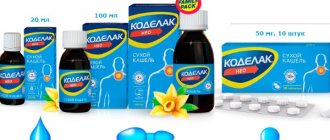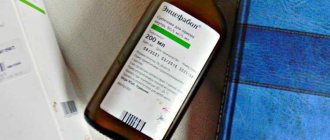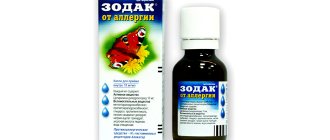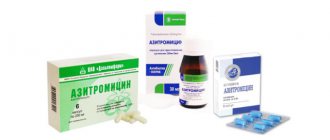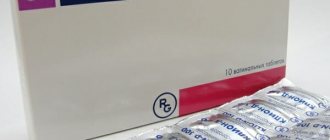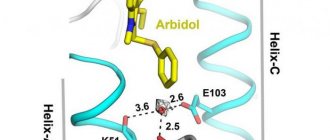To treat diseases of the oral cavity and pharynx, doctors often prescribe lozenges. This is a simple and safe way to relieve inflammation and reduce the unpleasant manifestations of the pathological process. One of the most effective and efficient medicines is Septolete, which is prescribed to both adults and children.
Septolete is a drug with an anesthetic and antimicrobial effect. The product has an antiseptic effect due to the benzalkonium chloride and thymol included in the composition. These substances have an effect on pathogenic microflora, viruses and fungi. The composition includes essential oils of menthol and mint, thanks to which it relieves sore throat and sore throat. Due to its composition, it helps to quickly get rid of the discomfort caused by the pathological process.
Release forms and composition of the drug
Septolete are sweet lozenges with a pleasant taste. The drug is produced by the famous Slovenian pharmaceutical company KRKA. One package contains 30 medicinal lozenges placed on 2 or 3 blisters.
Lozenges have a greenish tint, sometimes with yellow and white splashes. The manufacturer gave the lollipops a round shape and bulges on both sides.
Septolete are lozenges, but another dosage form of this drug is no less popular. In pharmacies, in addition to lozenges, you can find Septolete spray, which has a similar therapeutic effect. The spray is often purchased by those who like to dissolve tablets.
The principle of action of this drug is directly related to the properties of the main components.
Each lozenge contains the following substances:
| Content in 1 tablet, mg | Substance name | Description of the trace element |
| 1 mg | Benzalkonium chloride | The substance has a bactericidal effect on representatives of staphylococcal, streptococcal microorganisms, varieties of Escherichia coli, Klebsiella, and fungi. This component is effective against a whole list of bacterial strains that are resistant to antibiotics and other potent drugs, thanks to which Septolete prevents secondary infection of the wound surface. |
| 1 mg | Benzydamine | A representative of the group of non-steroidal anti-inflammatory substances, therefore it is responsible for eliminating pain, fever, and relieving inflammation. In medical practice it is used to relieve postoperative and post-traumatic pain syndrome and swelling. Local anesthetic relieves sore throat when swallowing and eating. |
| 0.5 mg | Cetylpyridinium chloride | It is an antiseptic that is effective against various bacteria and fungi. Cetylpyridinium is often found in medications intended to treat halitosis (various sprays and mouth rinses). This component prevents the formation of plaque on the tongue, but with prolonged use it can lead to darkening of tooth enamel and the appearance of aphthous ulcers. |
| 1.2 mg | Levomenthol | It has a weak antimicrobial and anti-inflammatory effect by irritating cold receptors. Levomenthol constricts blood vessels, creating the effect of slight freezing and numbness. |
| 1 mg | Peppermint oil | Irritates the nerve endings of the mucous membranes of the pharynx and oral cavity, eliminates pain and inflammation. |
| 1.2 mg | Thymol and eucalyptus oil | Helps ease breathing by reducing the production of mucus in the bronchi. |
Unlike a number of drugs intended to treat sore throat, Septolete does not contain sugar. A pleasant sweetish taste is provided by the sweeteners present in the composition. Septolete helps stop the spread of carious infection in the oral cavity - this is another reason why it is produced in the form of lozenges.
Septolete manufacturer's instructions
Compound
active ingredients
: benzydamine hydrochloride, cetylpyridinium chloride,
1 ml 1.5 mg benzydamine hydrochloride 5 mg cetylpyridinium chloride
Excipients:
Ethyl alcohol (96%), glycerin, macrogolglycerol hydroxystearate, sodium saccharin, peppermint oil, purified water.
Dosage form
Oral spray, solution.
Basic physical and chemical properties:
transparent solution from colorless to yellowish.
Pharmacotherapeutic group
Throat medications. Antiseptics.
ATX code R02A A20.
pharmachologic effect
Mechanism of action
Benzydamine hydrochloride is an NSAID and a pain reliever. The mechanism of action is believed to be related to the inhibition of prostaglandin synthesis and, therefore, a reduction in signs of inflammation (such as pain, redness, swelling, heat). Benzydamine hydrochloride also has a moderate local anesthetic effect.
Cetylpyridinium chloride is an antiseptic from the group of quaternary ammonium compounds. It acts as a cationic detergent. Quaternary ammonium compounds bind to the surface of bacterial cells, penetrate through it and bind to the cytoplasmic membrane of the microorganism. As a result of binding, the cytoplasmic membrane of microbes increases permeability to low molecular weight ingredients, mainly potassium ions. The quaternary ammonium compounds then enter the cell, disrupting the cell's functions and thus destroying it. Cetylpyridinium chloride has a broad spectrum of antimicrobial activity, as well as antifungal activity (for example, against Candida and Saccharomyces) and antiviral activity against some enveloped viruses. The most pronounced bactericidal effect is on gram-positive bacteria (in particular Staphylococcus). Gram-negative bacteria are moderately sensitive to cetylpyridinium chloride, whereas some strains of Pseudomonas are relatively insensitive.
Pharmacokinetics
Suction
From the two active substances, only benzydamine is absorbed, so pharmacokinetic interaction does not occur at the systemic level.
The absorption of benzydamine through the mucous membrane of the oral cavity and pharynx is indicated by the amounts detected in the serum, which are not sufficient to obtain a systemic effect.
Distribution
The volume of distribution of the drug in the form of lozenges and spray is the same.
Conclusion
It is excreted mainly in the urine and mainly in the form of inactive metabolites. The half-life and systemic clearance are similar in all dosage forms.
Indications
Symptomatic treatment of infections of the throat and oral cavity (pharyngitis, laryngitis, gingivitis, conditions before and after tooth extraction, etc.).
Contraindications
Hypersensitivity to the active substances or to any excipient.
Age up to 6 years.
Interaction with other drugs and other types of interactions
Septolete® total should not be used simultaneously with other antiseptics.
Features of application
Septolete® total should not be used for more than 7 days. If there is no improvement within 3 days, you should consult your doctor.
Septolete® total should not be used in combination with anionic compounds that are present in toothpastes (reduces the effectiveness of cetylpyridinium), therefore it is not recommended to use the drug immediately before or after brushing your teeth.
It is not recommended for use in the presence of wounds in the mouth due to delayed healing due to the action of cetylpyridinium chloride.
For severe infections accompanied by high fever, headache, vomiting, the patient should consult a doctor, especially in cases where the condition does not improve within three days.
If the patient suffers from chronic cough or hoarseness, a doctor should be consulted.
Direct contact of Septolete® total spray with the eyes should be avoided; the drug should not be inhaled.
This medicine contains small amounts of ethanol (alcohol), less than 100 mg/dose.
The ability to influence reaction speed when driving a vehicle or operating machinery
Septolete® total does not affect or has an insignificant effect on the reaction speed when driving vehicles or other mechanisms.
Use during pregnancy or breastfeeding
Pregnancy
Due to the lack of sufficient data, the use of Septolete® total is not recommended for pregnant women.
Breastfeeding period .
_ It is unknown whether the drug passes into breast milk, but a risk to newborns and infants cannot be excluded. The decision to stop breastfeeding or use Septolete® total should be made taking into account the benefits of breastfeeding for the child and the benefits of therapy for the woman.
Directions for use and doses
Adults and children over 12 years of age, one dose is 1-2 pumps. Repeat every 2:00 3-5 times a day.
For elderly patients, the recommended dose is the dose.
Children aged 6 to 12 years, one dose is 1 pump. Repeat every 2:00 3-5 times a day.
For optimal results, do not use the product immediately before or after brushing your teeth.
Do not exceed recommended doses.
Septolete® total can be used for 7 days.
Mode of application
Before using Septolete® Total for the first time or if the spray has not been used for a long period of time (at least 1 week), press the dispensing spray several times to obtain an even spray.
Before use, remove the plastic cover.
Open your mouth wide, point the spray nozzle towards your throat and press 1-2 times. Hold your breath while spraying.
After each use, close the spray bottle with a plastic cap.
Pressing once releases 0.1 ml of a spray solution containing 0.15 mg benzydamine hydrochloride and 0.5 mg cetylpyridinium chloride.
Children
Use in children under 6 years of age is contraindicated due to the dosage form.
Children 6-11 years old use this drug under adult supervision.
Overdose
Due to the low concentrations of both active substances in the composition of Septolete® total, overdose is impossible when used in recommended doses.
Symptoms
Toxic manifestations of benzydamine overdose include agitation, convulsions, sweating, ataxia, tremor and vomiting.
Signs and symptoms of intoxication after taking significant doses of cetylpyridinium chloride are nausea, vomiting, shortness of breath, cyanosis, asphyxia due to paralysis of the respiratory muscles, central nervous system depression, arterial hypotension and coma. The lethal dose for humans is approximately 1-3 grams (which exceeds the maximum daily dose of Septolete® total spray by 200-600 times).
Treatment _ _
Since there is no specific antidote, treatment of acute overdose is symptomatic.
Adverse reactions
Very often ≥1/10;
often ≥1/100 - <1/10;
uncommon ≥1/1000 - <1/100;
rarely ≥1/10000 - <1/1000;
very rarely <1/10000.
unknown (cannot be estimated from available data)
| Organ system | Rarely | Very rarely | Unknown |
| From the immune system | hypersensitivity reactions | ||
| From the respiratory system | bronchospasm | laryngospasm | |
| From the gastrointestinal tract | burning sensation in the mouth, dry mouth | irritation in the mouth | loss of sensitivity in the oral mucosa |
| From the skin and subcutaneous tissues | urticaria, photosensitivity |
If any unwanted reactions occur, you should stop treatment and consult your doctor.
Best before date
2 years.
After opening the bottle, the drug should be used within 6 months.
Storage conditions
Store at a temperature not exceeding 25 ° C. Keep out of the reach of children.
Package
30 ml in a plastic bottle made of high-density polyethylene with a white dispensing spray and a blue polypropylene cap in a cardboard box.
Vacation category
Over the counter.
Manufacturer
KRKA, d.d., Novo Mesto, Slovenia
Manufacturer's location and address of place of business
Šmarješka cesta 6, 8501 Novo Mesto, Slovenia
© Translation into Russian by the editorial team of apteka24.ua.
Source: “State register of medicinal facilities of Ukraine”, 2020.
Pharmacological properties
Septolete is used when unpleasant sensations appear in the throat that haunt the patient during eating, swallowing, breathing, and talking. The active components in this drug have an antiseptic effect, as if creating a protective bactericidal film.
Septolete is effective against respiratory viral and fungal agents. Lozenges suppress the activity of the herpes simplex virus.
This drug is used not only in therapy, but also in dentistry for the purpose of sanitation of the oral cavity. Septolete can be used as a mild anesthetic for gum disease. In otolaryngology, the drug is used in preparing the nasopharynx and pharynx for surgery.
Thanks to peppermint essential oil, lozenges stimulate nerve endings in the mucous membrane and eliminate spasms. Throat tablets help with inflammation of the vocal cords and hoarseness, softening the throat and improving the general well-being of the patient. Eucalyptus oil, present in the lozenges, facilitates breathing and prevents the release of excess mucus from the respiratory tract.
Pharmacodynamics and pharmacokinetics
The main task of Septolete tablets is to relieve pain and relieve inflammation. This can be achieved through the influence of benzydamine, a local anesthetic from the NSAID group.
Of no small importance are benzalkonium chloride and cetylpyridinium chloride - antiseptic substances from the group of quaternary ammonium compounds that kill bacteria, fungi and viruses on the surface of the mucosa.
Septolete are lozenges, the active components of which partially penetrate into the blood through the mucous membrane. Moreover, all active ingredients do not interact with each other. Benzydamine penetrates into the blood to a greater extent, which was proven in laboratory studies.
This substance enters the blood and accumulates in maximum quantities, in comparison with other components of Septolete. However, the confirmed amount of benzydamine is not sufficient to have a systemic effect on the body.
When using the non-tablet dosage form Septolete, the absorption of benzydamine is higher, which undoubtedly should be taken into account when choosing a treatment method. The drug is excreted from the body primarily by the urinary system in the modified form of inactive metabolites.
Is Septoleta allowed for children?
According to official instructions, it is unacceptable to give to children under 4 years of age. Therefore, for safety reasons, for the treatment of the youngest patients it will be necessary to resort to the use of another drug prescribed by the pediatrician. It is especially dangerous to give to young children contrary to the instructions, because. the likelihood of an allergic reaction is very high.
Price – about 250 rubles
Some parents ignore the information specified in the official instructions: they give it to their children as soon as the kids begin to complain of a sore throat. This should not be done under any circumstances: such an approach may not only be ineffective, but also cause a number of complications.
Composition of throat antiseptic
One tablet contains 1.0 mg of benzalkonium chloride levomenthol, this is the main active ingredient. Auxiliary components include:
- essential oil of mint and eucalyptus;
- glycerol;
- liquid paraffin;
- lactose monohydrate;
- sorbitol;
- refined castor oil;
- magnesium stearate;
- glucose;
- dyes;
- sucrose.
Indications for use of antiseptic for throat
Always prescribed as part of complex treatment of diseases. This number includes the following pathologies:
- stomatitis;
- gingivitis;
- laryngitis;
- tonsillitis;
- pharyngitis.
Regardless of what disease was diagnosed in the baby, it is not recommended to give this drug without consulting a doctor. Otherwise, parents expose the baby to great risk, because It is not always the case that therapy for a particular pathology of the throat or oral cavity is carried out with this particular drug.
Are there any contraindications
Has some contraindications for use. This list includes:
- galactosemia;
- galactose/glucose malabsorption syndrome;
- isomaltose enzyme deficiency;
- fructose intolerance;
- allergic manifestations;
- children up to 4 years old.
Therefore, before giving it to your baby, you need to read the instructions and exclude any possible contraindications.
At what age can you take it?
According to the instructions, it can be given to children from 4 years of age. It is worth noting that the Septolete Plus dosage form should not be given to children under 6 years of age. This need is due to insufficient data on the safety of the effects on the body of children. And instructions for use of Angin Hel can be found at the link.
Indications for use
The scope of use of the drug Septolete is wide. The medication is used for inflammation and sore throat. For colds and acute respiratory viral infections, lozenges eliminate soreness, swelling, and hyperemia of the laryngeal mucosa.
The main indications for use of Septolete are:
- pharyngitis;
- tonsillitis;
- laryngitis.
In order for the lozenges to produce the maximum therapeutic effect, you need to start dissolving them at the first symptoms of the disease. With a strong irritating cough, Septolete acts quickly, softening the throat and eliminating soreness.
The second group of diseases for which tablets are used for local treatment are gingivitis and stomatitis. As an adjuvant treatment, Septolete is prescribed for ARVI, influenza, inflammatory gum disease, halitosis of any etiology. This medication is also used for hoarseness of voice and difficulty in nasal breathing.
In case of acute inflammation of the lymphoid tissue of the nasopharynx and trachea, the drug is used exclusively on the recommendation of a doctor, therefore self-medication without consulting a specialist is not recommended.
Contraindications
Since this drug has a complex composition, in some cases its use should be abandoned. In particular, patients with increased sensitivity to any of the active ingredients in the drug should not take Septolete.
The second group of contraindications includes hereditary disorders of the digestive system associated with sucrase-isomaltase deficiency against the background of galactose and glucose malabsorption syndrome. With this genetic failure, the human body is not able to accept and metabolize specific sugars - glucose and galactose.
The manufacturer's annotation does not contain any recommendations for the use of the drug by persons prone to developing unwanted allergic reactions. According to doctors, such patients should be especially careful when using Septolete, since all the active components of the lozenges are allergenic.
It is not advisable for pregnant and lactating women to take lozenges for sore throat, since there is no verified information about the safe effects of the drug on the fetus. The active components of Septolete penetrate into the bloodstream and, therefore, into breast milk. Therefore, during treatment, lactation should be suspended or a safer drug should be selected.
At what age can the drug be used?
The official instructions for Septoleta indicate that lozenges should not be given to children under 4 years of age. However, in practice, judging by the responses, doctors often ignore this limitation and prescribe the drug to children at an earlier age.
Such a decision by a specialist can without any doubt be considered unprofessional and reckless, since children aged 2-3 years are not yet able to control the process of resorption of lozenges. In addition, the dosage of active ingredients may be excessive for the child, which is fraught with negative consequences.
Instructions for use, dosage
Lozenges are used every 3-6 hours. The regimen for using Septolete is simple: the lozenge must be kept in the mouth until it is completely dissolved.
The frequency of taking tablets depends on the patient’s age:
- Adults and adolescents can dissolve no more than 8 lozenges per day - this is the maximum allowable amount of the drug. If the symptoms are mild, you can take fewer tablets.
- Children from 10 to 12 years old are recommended to use 1 lozenge every 4 hours. The maximum daily amount is 6 tablets.
- Patients aged 4 to 10 years should not be given Septoleta more than 4 times a day. Thus, a 6-hour interval should be maintained between each dose of the drug.
It is not advisable to dissolve the tablets immediately before meals or during meals - in this case, the treatment will not bring any results. It is not recommended to drink or eat 1 hour before using the lozenge and for 1 hour after eating.
Also, you should not take the drug with dairy products, which can reduce the degree of antiseptic effects of benzalkonium chloride and cetylpyridinium chloride. On average, the duration of treatment is 3-7 days.
Side effects
Taking Septolete can provoke the development of adverse reactions. Based on numerous reviews of this drug, problems of this kind occur extremely rarely.
However, the manufacturer himself does not exclude the possibility of side effects in the form of:
- nausea throughout the entire treatment period;
- change in stool;
- headache;
- itching and rashes on the skin;
- hives.
There are no other side effects or events that could lead to serious complications. If such reactions or discomfort or weakness occur, you should consult your doctor.
As a rule, side effects are not grounds for discontinuing the drug and stopping treatment. However, in individual cases, the doctor may decide to reduce the dosage or replace Septoleta with an analogue.
Danger of overdose
Overdose occurs in very rare cases. Typically, its symptoms are observed when consuming more than ten lozenges per day.
Signs of overdose include:
- diarrhea;
- vomit;
- skin rashes.
If these signs occur, stop using the medication. It is recommended that in case of overdose, drink plenty of fluids. Consultation with your attending physician is also advisable.
In case of an overdose of an aerosol, the following reactions may occur:
- increased sweating;
- convulsions;
- vomit;
- shortness of breath;
- lack of coordination;
- nervous overexcitation;
- decrease in pressure;
- tremor.
If such symptoms are observed, then medications are prescribed for symptomatic therapy.
The danger of an overdose of the spray is that high doses of cetylpyridinium can lead to serious complications. The development of coma cannot be ruled out. Exceeding doses of this substance can be fatal.
Overdose
Septolete are lozenges, which today are considered insufficiently studied. There is no verified information about overdose with this drug.
When there is an excess of benzalkonium chloride and cetylpyridinium chloride in the blood, the following clinical signs appear:
- nausea;
- vomit;
- increased sweating;
- excited state, anxiety;
- convulsions;
- diarrhea;
- dizziness.
If such symptoms appear, you should call an ambulance or begin symptomatic treatment of intoxication yourself by taking absorbents.
Since there are no specific antidotes for benzadamine, traditional therapeutic tactics are used to combat drug poisoning of the body. It is worth noting that the lethal dose for humans is approximately 1000 mg of cetylpyridinium chloride, which is equal to 2000 Septolete lozenges.
Compound
1 lozenge [lemon and honey] contains:
Active ingredients: Benzydamine hydrochloride 3,000 mg Cetylpyridinium chloride monohydrate 1,050 mg, equivalent to cetylpyridinium chloride 1,000 mg
Excipients: isomalt (type M) (E953), citric acid (E330), sucralose (E955), honey flavor, lemon flavor, levomenthol, curcumin dye (E100)1), peppermint leaf oil 1) Curcumin dye (E100) : curcumin (E100), maltodextrin, acacia gum (E414), emulsifier (E472c), citric acid (E330), potassium sorbate (E202), sodium benzoate (E211), purified water.
special instructions
If there are ulcerative lesions of the mucous membrane of the oral or nasal cavity, treatment should be carried out under the supervision of a physician. If the symptoms of the disease persist for 3 days or more of taking Septoleta, you should choose another drug.
It is not advisable to dissolve lozenges simultaneously with other local anesthetics or anti-inflammatory drugs.
It should also be taken into account that anionic chemical compounds contained in toothpastes and rinses can neutralize the effect of Septolete, so it is best to take the tablet 1 hour after brushing your teeth.
Lozenges and Septolete spray cannot be used at the same time to avoid overdose of active substances. None of these dosage forms affects the reaction and attentiveness of patients, as well as their ability to drive a car or other mechanisms. Also, Septolete has nothing to do with cognitive and psychomotor functions.
Special instructions for the use of the drug Septolete, Septolete d
Each Septolete lozenge contains 0.64 g of sugar, Septolete D - almost 0.8 g of maltitol, which must be taken into account by patients with diabetes. Insulin is required for the metabolic breakdown of maltitol, but due to its slow hydrolysis and absorption in the gastrointestinal tract, the glycemic index is negligible. The energy value of maltitol (10 kJ/g, or 2.4 kcal/g) is also significantly lower than the energy value of sucrose. Lozenges are not recommended to be taken with milk, since milk reduces the antimicrobial activity of benzalkonium chloride. Outpatients should be advised that if they experience high fever, headache or vomiting, they should seek medical attention. The use of the drug during pregnancy and breastfeeding is possible only under the supervision of a doctor.
Drug interactions
The specifics of the interaction of active substances continue to be studied, but it is already known that during treatment with Septolete it is not advisable for the patient to use additional drugs from the group of local antiseptics.
Especially when we are talking about medications with a similar composition. Otherwise, parallel use of oral antiseptics can lead to an overdose and the development of serious allergic reactions.
Septolete are lozenges that are not the main treatment for diseases of the throat and oral cavity. The drug can be used together with antibiotics, mucolytics, antiviral and antihistamine medications.
Cost of the drug and analogues, drug interactions
During treatment with Septoleta, it is better to avoid other antiseptics intended for resorption: simultaneous use may reduce the effectiveness of the drugs, as a result of which treatment will be delayed. The most popular analogues for the main active ingredient are:
- Septole Neo;
- Septolete D;
- Septolete Plus.
Cost – about 250 rubles
Analogs by pharmaceutical group:
- Agisept;
- Anti Angin Formula;
- Benzalkonium fluoride;
- Vinylin;
- Hexicon;
- Dentamet;
- Yox;
- Katatcel;
- Collargol;
- Lidocaine Asept;
- Miramistin;
- Protargol;
- Rinza Lorsept;
- Stomatidin;
- Suprima ENT;
- Travisil;
- Faringosept;
- Chlorhexidine;
- Eucalymin;
- Elakosept.
You can buy Septolete lozenges for a price starting from 170 rubles.
Analogs
Despite the fact that you can buy Septolete lozenges at a pharmacy without an official prescription from a doctor, you should not overuse self-medication. If after 3 days of use the expected result has not yet occurred, you should consult a doctor to select an analogue of the drug that contains the same active ingredients or has a similar principle of action.
It is worth noting that other drugs in the Septolete series are analogues of these tablets.
Their differences from ordinary lozenges are as follows:
- Septolete Neo. The active ingredient of the drug is cetylpyridinium chloride. Also available in the form of lozenges for resorption. Unlike regular Septolete, Neo can be used by pregnant women and nursing mothers. In addition, Septolete Neo tablets have apple, lemon or cherry flavors.
- Septolete Plus. Benzocaine is used as an anesthetic. The product is available only in the form of a spray, which has serious restrictions on use (for example, children under 12 years of age, pregnancy and lactation).
- Septolete Total. In pharmacies, the drug is sold in the form of lozenges and spray for irrigating the throat and mouth. Total is identical to the Septoleta in question, but the main difference is the dosage. There is 3 times more benzydamine, and 2 times more cetylpyridinium chloride. In this regard, Total is not used during pregnancy and breastfeeding, either in the form of a spray (it is also contraindicated for children under 18 years of age), or in the form of lozenges (allowed from the age of 12).
In addition to the Septolete series drugs, you can purchase other analogues in pharmacies:
- Faringosept – a drug based on ambazone monohydrate, especially effective against streptococcal and pneumococcal infections. Faringosept is available in lozenges with lemon or cocoa flavor. The drug is not used in children under 3 years of age and is also contraindicated in pregnant and lactating women.
- Sebidine is a combined medication based on chlorhexidine and ascorbic acid, which has an antiseptic effect. Release form: lozenges. It is approved for use during pregnancy and lactation.
- Hexalize is an antibacterial and antiviral agent that stops the inflammatory process. Available in the same form as Septolete. Suitable for treating children over 6 years of age.
- Falimint is a similar remedy that has a complex effect. It has a single form of release - dragees. Falimint belongs to Septoleta's analogues in the therapeutic group.
Description of the product
The drug belongs to antiseptic drugs that are prescribed for complex therapy of otolaryngological diseases. Used for inflammation of the oral cavity in dental practice.
The medicine is intended for local use. Septolete is an effective remedy for bacterial infections, since it acts directly on the site of inflammation.
Composition and dosage forms
The medicine contains the following active ingredients:
- benzalkonium;
- levomenthol;
- eucalyptus leaf oil;
- thymol;
- mint oil.
In addition, the drug in the dosage form of tablets and lozenges contains other auxiliary components:
- lactose;
- sorbitol;
- titanium dioxide;
- magnesium stearate;
- povidone;
- glycerol;
- dyes.
Septolete spray also contains cetylpyridinium chloride.
The drug is available in the following forms:
- in lozenges (available in 15 or 10 pieces in one blister);
- in Septolete tablets for resorption;
- in candies (produced with cherry, lemon and apple flavors and aroma);
- Septolete D (lollipops without added sugar);
- spray.
In the form of a spray and lozenges, you can buy Septolete Total or Septolete Plus at the pharmacy.
Terms, conditions of sale and storage
Like other medicines, Septolete should be stored in a place that is inaccessible to children. Complex and specific conditions for saving this drug are not required.
It is enough to follow the standard restrictions:
- The tablets should be in a carton at room temperature.
- The shelf life of Septolete is 2 years from the date of release (the date of manufacture is indicated on the cardboard box or blister).
- Keep the medicine away from direct sunlight.
